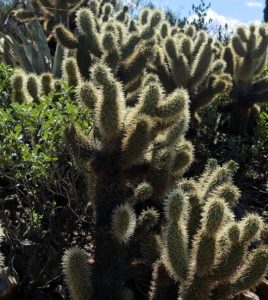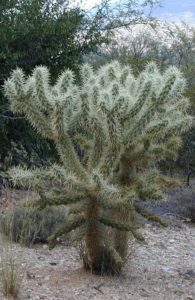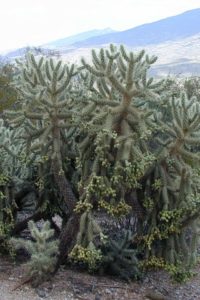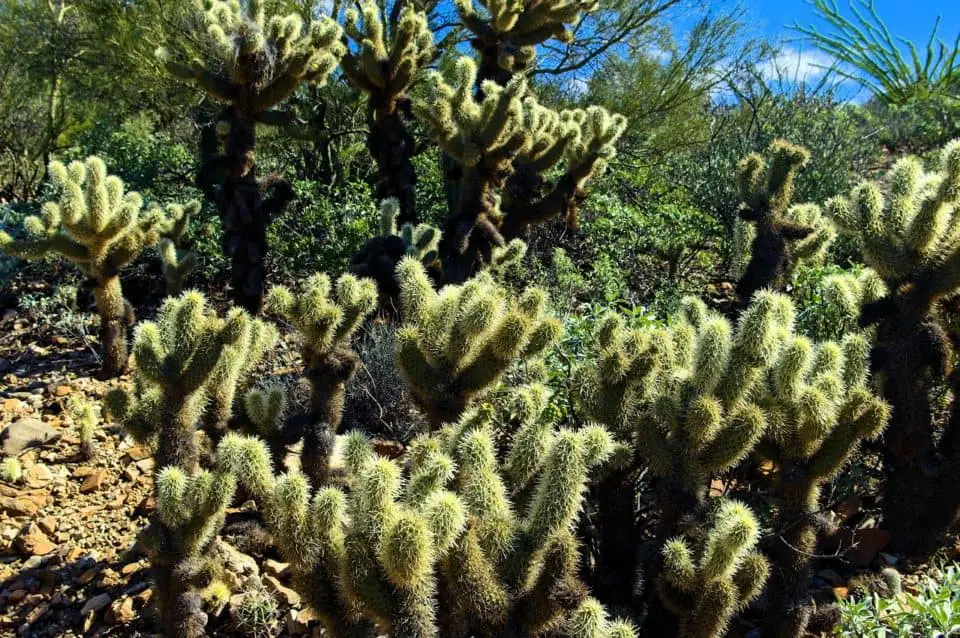Some links in the post are affiliate links and I get a commission from purchases made through some links found in the post.
Cholla Cactus is a famous plant that is famous in North America. This type of cactus can grow from anywhere between one to fifteen feet tall and can thrive in mountain forests or rocky flats or slopes.
There are more than 20 types of Cholla cactus and some of the famous ones are jumping cholla and teddy bear cholla.
This type of cactus represents more than 20 species of the family cactaceae in the North American deserts.
The reason they are called Cholla is because of their shrubby cacti with cylindrical stems. They compose of segmented joints.
These stems have quite a few purposes including helping when there’s a water shortage, photosynthesis and flower production.
Chollas also have tubercles like most cacti. They are short and wart-like that have sharp spines but here is where leaves grow!
This type of cactus is also one of the only one that has papery sheaths covering their spines. This is what makes this type of cactus stand apart from the rest of them.
Jumping Cholla Vs Teddy Bear Cholla – What is The Difference?
 Jumping Cholla is also known as silver cholla. It has an attractive outlook but has an odd look and has dense masses of spine.
Jumping Cholla is also known as silver cholla. It has an attractive outlook but has an odd look and has dense masses of spine.
The reason it is called jumping cholla is because the spine of this cactus can jump on any passer by. It can be grown in desert-like conditions and plant hardiness is zone 8 or above.
Jumping cholla is native to Northwest Mexico and can reach 5 to 9 feet in height. Its spines are silverish gold when young but as it ages its colour changes to brown or black.
Teddy bear cholla have chocolate brown stems with fuzzy golden arms. They grow in a close clustered format.
Like living in small societies and is a sight to see when the sun rises or falls in the desert sky. You should always remember two things about teddy bear cholla.
Although they are friendly, they are eager to detach themselves. They travel and take root elsewhere as well as they are determined to become a cholla propagator!
A teddy bear cholla has sharp spines covering its stem densely. They are also a popular nesting site for birds. Teddy bear cholla travels far and wide and is waiting to be detached from its stem.
Does Cholla Cactus Really Jump?
Cholla cactus can come into contact with anyone near them and it can be quite painful. It can become an aggressive menace quite quickly!
This type of cactus has a unique outlook and while it can add beauty to your yard it can also provide a barrier to any thief or burglar trying to get inside your house.
The Cholla cactus has sharp spines with masses of hard and fine irritating barbs. They are called glochids.
As soon as skin comes in contact with this plant the segment of the plant comes off and attaches to your skin. They then turn in a reverse direction which makes it quite impossible to remove.
Why Is It Called A Teddy Bear Cholla?
A teddy bear cholla belongs to the group Opuntia. It is a group of cacti that has spiny and prickly spines. The teddy bear cholla has four characteristics that distinguishes teddy bear cholla from another cactus:
- It has joined segments.
- Its areolas have miniture barbed spices that are easily detachable.
- Rudimentary leaves are present on new joints.
- Their seeds have a unique covering called aril.
Teddy bear cholla gets its name due to its appearance. It has extremely close and fine spines which gives it an almost fuzzy look.
The teddy bear cholla resembles a teddy bear and has a central trunk. It can grow from anywhere between 3 to 5 feet.
It has segmented side branches which grow near the top. The spikes are light in colour but as it ages it changes colour to black or brown.
You may also like: how to propagate a Christmas cactus.
Is Jumping Cholla Dangerous?
Jumping Cholla is one of the most dangerous plants in the desert. If the jumping cholla attaches to you it’s boxing glove goes into your skin.
If you try to remove the jumping cholla by shaking it might hit your face or anyone else near you. You also cannot suck them with your mouth as it can attach itself to the inner side of your mouth, tongue or throat.
Teddy Bear Cholla Facts
 Teddy bear cholla has spines that detach itself from its stem and attach to anyone who comes in contact with it.
Teddy bear cholla has spines that detach itself from its stem and attach to anyone who comes in contact with it.
Although this plant looks beautiful when you add it to your garden. Don’t forget the dangers of this plant. Let’s take a look at some teddy bear cholla facts.
- Its stems are separated into segments.
- This is what allows teddy bear cholla to store water and allow photosynthesis.
- Its spines are what saves it from the heat of the desert.
- Water and light are the main source of food for this plant.
- It has a greenish gold colour.
- It has a fuzzy look when you see it from a distance.
- The fuzzy appearance is due to its silver spine.
- It grows in low elevation desert areas below 3000 feet.
- The plant blooms in spring and has 1.5 inches wide flowers.
- It has flowers that are white or lavender.
- Pack rats also pile the joints of this plant to ward off predators.
Jumping Cholla Facts
Jumping cholla cactus get its name from spiny segments that detach itself easily to attack anyone near them.
Many people have had some nasty experiences with the jumping cholla. Let’s look at some facts of jumping cholla cactus.
- They don’t actually jump but detach themselves easily from the main plant.
- The reason it does this is to survive.
- It spreads like this because when it detaches itself and goes elsewhere its roots grow there.
- If you try to remove the spine of the jumping cholla it will fall on the floor and root itself there.
- It has long chains of spineless fruits hanging from the trunk.
- They can be 10 to 12 fruits long.
- They are one of the largest cacti.
- It will grow beautiful lavender pink flowers from May to June.
Defense Strategies from Jumping Cholla
To prepare yourself to stay protected from jumping cholla try not to walk too close or near it. It’s common for jumping chollas fallen spikes to attach themselves to shoes or skin.
If you’re hiking in an area where jumping chollas are common then always carry your essentials with you.
A big tooth comb or a long pair of forceps will also work. If you don’t have these things with you then look for two sturdy stickers and use them to pull out the spines out of your skin.
If you are enjoying this article, check out our article on why is your cactus dying.
Teddy Bear Cholla Growth Rate
Growth rate of a teddy bear cholla is slow. It loves a full sun exposure and is tolerant to drought areas or with less water. It flowers during spring and is found in Sonoran desert and Mojave desert.
Good to Know Things About Cholla Cacti
Cholla cacti have many different species and are found in desert-like areas. This type of cacti can survive harsh conditions and loves direct and full bright sun exposure.
Read more to know some facts about cholla cacti.
- They can live in their natural habitat for decades.
- They love bright and direct sunlight.
- Whether you’re growing them indoor or outdoor make sure to place them in an area where there’s direct and bright sunlight.
- It’s a good idea to leave your cholla cactus alone. Since they are used to less water you don’t need to water them too frequently.
- Plant them in soil that is desert like.
- If you’re growing them in a container, place them in a pot which has drainage holes.
- Maintain the fresh look of cholla cactus by regularly pruning them.
It can be a little difficult to grow Cholla cactus because they are covered in spines. But with a little patience you will learn how to care for them. Make sure you expose the cholla cacti to at least six hours of direct sunlight per day.
Cholla cactus are hardy plants that prefer warm temperatures but can also tolerate cold temperatures but only for a short period of time.
Cholla cactus are used to dry conditions so to ensure that cholla cactus feel like they are in their natural habitat plant it in a well draining soil with average pH.
Final Thoughts: Jumping Cholla Vs Teddy Bear Cholla
 Cholla cactus can do well in most environmental conditions. They love warm and sunny days and with a little bit of care you will see your cholla cacti growing into a beautiful plant with flowers.
Cholla cactus can do well in most environmental conditions. They love warm and sunny days and with a little bit of care you will see your cholla cacti growing into a beautiful plant with flowers.
Teddy bear cholla vs jumping cactus look extremely beautiful in any landscape however due to its dangerous features people often try to not plant them within their homes.
However, since they don’t require too much care these plants can be for those people who are lazy in taking care of their plants and want a nice scenery around their house.
These two types of cactus are famous for their outlooks but also for how well they adapt to extreme weather!
If you enjoyed this article, check out our article on why are my cactus needles turning brown.


